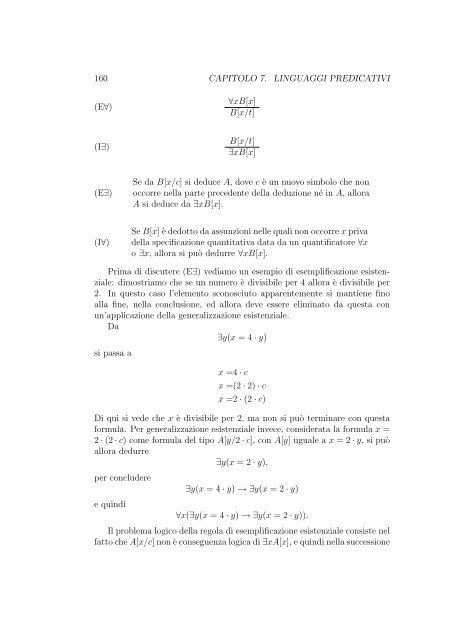Logica Matematica Corso di Laurea in Informatica ... - Mbox.dmi.unict.it
Logica Matematica Corso di Laurea in Informatica ... - Mbox.dmi.unict.it
Logica Matematica Corso di Laurea in Informatica ... - Mbox.dmi.unict.it
Create successful ePaper yourself
Turn your PDF publications into a flip-book with our unique Google optimized e-Paper software.
160 CAPITOLO 7. LINGUAGGI PREDICATIVI<br />
(E∀)<br />
(I∃)<br />
(E∃)<br />
(I∀)<br />
∀xB[x]<br />
B[x/t]<br />
B[x/t]<br />
∃xB[x]<br />
Se da B[x/c] si deduce A, dove c è un nuovo simbolo che non<br />
occorre nella parte precedente della deduzione né <strong>in</strong> A, allora<br />
A si deduce da ∃xB[x].<br />
Se B[x] è dedotto da assunzioni nelle quali non occorre x priva<br />
della specificazione quant<strong>it</strong>ativa data da un quantificatore ∀x<br />
o ∃x, allora si può dedurre ∀xB[x].<br />
Prima <strong>di</strong> <strong>di</strong>scutere (E∃) ve<strong>di</strong>amo un esempio <strong>di</strong> esemplificazione esistenziale:<br />
<strong>di</strong>mostriamo che se un numero è <strong>di</strong>visibile per 4 allora è <strong>di</strong>visibile per<br />
2. In questo caso l’elemento sconosciuto apparentemente si mantiene f<strong>in</strong>o<br />
alla f<strong>in</strong>e, nella conclusione, ed allora deve essere elim<strong>in</strong>ato da questa con<br />
un’applicazione della generalizzazione esistenziale.<br />
Da<br />
∃y(x = 4 · y)<br />
si passa a<br />
x =4 · c<br />
x =(2 · 2) · c<br />
x =2 · (2 · c)<br />
Di qui si vede che x è <strong>di</strong>visibile per 2, ma non si può term<strong>in</strong>are con questa<br />
formula. Per generalizzazione esistenziale <strong>in</strong>vece, considerata la formula x =<br />
2 · (2 · c) come formula del tipo A[y/2 · c], con A[y] uguale a x = 2 · y, si può<br />
allora dedurre<br />
∃y(x = 2 · y),<br />
per concludere<br />
e qu<strong>in</strong><strong>di</strong><br />
∃y(x = 4 · y) → ∃y(x = 2 · y)<br />
∀x(∃y(x = 4 · y) → ∃y(x = 2 · y)).<br />
Il problema logico della regola <strong>di</strong> esemplificazione esistenziale consiste nel<br />
fatto che A[x/c] non è conseguenza logica <strong>di</strong> ∃xA[x], e qu<strong>in</strong><strong>di</strong> nella successione




![Introduzione ai sistemi Wiki [PDF] - Mbox.dmi.unict.it](https://img.yumpu.com/16413205/1/184x260/introduzione-ai-sistemi-wiki-pdf-mboxdmiunictit.jpg?quality=85)











